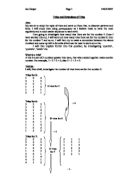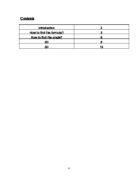5 2 1
1 3 4
1 4 3
3 4 1
3 1 4
4 3 1
4 1 3
6 1 1
1 6 1
1 1 6
2 2 4
2 4 2
4 2 4
2 3 3
3 2 3
3 3 2
Numbers of trios:
5 → 6
6 → 10
7 → 15
8 → 21
I have noticed, by looking at the numbers of trios for 5, 6, 7, and 8, that they are all triangular numbers.
A triangular number is a number which can be ‘stacked’ to make a triangle. For example, if I take some cans of coke and stack them on top of each other, I have to use a certain number of cans for my ‘coke pyramid’ to look correct. For example: I could put 5 cans on the bottom row, 4 cans on the next, 3 cans on the next row, 2 cans on the next row, and one can on top. This would make a ‘regular pyramidal’ shape. The diagram below illustrates this.
The total number of cans in this model is 15; hence it is a triangular number. The next triangular number is 21 which is achieved by adding 6 cans to the bottom of the above model, and the next triangular number is made by adding 7 onto that.
The formula for a triangular number is:
Since the number of trios for a certain number is always triangular, I can adapt the formula for triangular numbers to come up with a formula for trios. That formula is:
(n-1)(n-2)
2
I will now test this formula:
How many trios for the number 7?
(7-1)(7-2)
6 x 5 = 30 30 / 2 = 15
This proves that my formula works! I know this because I know that 15 is a triangular number and I also know that it is true that there are 15 trios for 7 because I have worked it out on page 1.
Now that I have proven my formula for trios, I can progress and work out the formula for ‘quartets’.
QUARTETS:
I will first of all investigate how many quartets there are for the number 5:
Quartets for 5:
2 1 1 1
1 2 1 1
1 1 2 1
1 1 1 2
Quartet for 6:
2 2 1 1
2 1 2 1
2 1 1 2
1 2 2 1
1 2 1 2
1 1 2 2
3 1 1 1
1 3 1 1
1 1 3 1
1 1 1 3
Quartets for 7:
1 1 1 4
1 1 4 1
1 4 1 1
4 1 1 1
1 1 2 3
1 1 3 2
1 2 3 1
1 3 2 1
1 3 1 2
1 2 1 3
2 2 2 1
2 2 1 2
2 1 2 2
1 2 2 2
3 2 1 1
3 1 2 1
3 1 1 2
2 3 1 1
2 1 3 1
2 1 1 3
Number of quartets:
5 → 4
6 → 10
7 → 20
Difference between numbers of quartets:
4 → 10 = 6
10 → 20 = 10
6 and 10 are triangular numbers. This suggests to me that there are connections between the formula for trios, which is relative to the formula for triangular numbers, and the formula for quartets. This means that the formula for trios can, once again, be adapted to fit in with quartets. The formula for quartets is:
(n-1)(n-2)(n-3)
It is becoming apparent that the formula for trios and quartets are distinctly related. The formula that works, which I have shown above, is the same as the formula for trios but with another (n-3) on the end. On the top row, for trios, the formula is
(n-1)(n-2). For quartets, the formula is (n-1)(n-2)(n-3). It is very apparent that the firs two brackets are the same, and that there is a very distinct sequence of 1, 2, and 3. Therefore, I am now making the prediction that the formula for quintets will follow suit and be: (n-1)(n-2)(n-3)(n-4)
At this point, I must explain why the bottom number is as it is. I have deduced that, the bottom numbers also follow a pattern of their own. They are all factorials. I worked this out when I was working on the formula for quartets. I discovered the sequence on the top row, and then tried to divide it all by 2, as for trios. However, this did not work, and I was left with the dilemma of trying to find a sequence which enabled me to come up with the bottom number. I worked out what the bottom number was manually for quartets, using what I knew about the top row and then noticed that these numbers (2 and 6) are factorials. A factorial is a number that is made from a sequence of numbers starting from 1, by multiplying them together. For example, factorial 4 is the number 4 multiplied by every integer down to one inclusive. I.e. Factorial 4 is: 1 x 2 x 3 x 4 = 24 and factorial 5 is: 1 x 2 x 3 x 4 x 5 = 120.
I then had to work out which number factorial to put down. I discovered, by looking at the lower number on the formula for trios, that it is 2 factorial and that the lower number on quartets is 3 factorial. This leads me to believe that the number factorial to use is one less than the device you are using. For example, if I am using sextets, which is the sum of 6 numbers, then the factorial to use would be 5 factorial. Likewise, if I were using quintets, the factorial to use would be 4 factorial as it is one lower that 5 which is the device being used.
Now that I think I have worked out a sequence of formulas which work for any device (trios, quartets, quintets, sextets, septets etc.), I will put it to the test on quintets.
QUINTETS:
I do not need to investigate all the numbers with quintets as I have done with trios and quartets as I believe that I already have the formula. I must, however, check using one number (I choose 6) in order to make sure that the formula I have created actually works.
I predict, using the formula: (n-1)(n-2)(n-3)(n-4) , that there will be 5 quintets for the number 6.
Quintets for 6:
1 1 1 1 2
1 1 1 2 1
1 1 2 1 1
1 2 1 1 1
2 1 1 1 1
This concludes that so far, my formula for working out trios, quartets, quintets etc works. I will finalise and verify this by trying it again but this time using sextets for the number 7.
This means that I will use the formula: (n-1)(n-2)(n-3)(n-4)(n-5)
Using this formula, I predict that there will be 6 sextets for the number 7.
Sextets for 7:
1 1 1 1 1 2
1 1 1 1 2 1
1 1 1 2 1 1
1 1 2 1 1 1
1 2 1 1 1 1
2 1 1 1 1 1
This works. I can now reliably say that I have come up with the sequence of formulas for trios, quartets, quintets, sextets, septets etc.
Findings:
I have discovered that trios have a direct link with triangular numbers. Upon realising that, I was able to adapt the formula for triangular numbers into a working formula for trios. From there, I was able to connect the formula for trios with a working formula for quartets. When I discovered that the link was triangular numbers, I was able to adapt what I knew about triangular numbers, and the sequence between the formulas that I had found, to create a sequence of formulas, that can be used.
The formulas that I discovered are these:
Trios: (n-1)(n-2)
Quartets: (n-1)(n-2)(n-3)
Quintets: (n-1)(n-2)(n-3)(n-4)
Sextets: (n-1)(n-2)(n-3)(n-4)(n-5)
Septets: (n-1)(n-2)(n-3)(n-4)(n-5)(n-6)
I know how many set of brackets to use for each device by obeying this rule: The number of brackets to be used is 1 less than the device selected. Therefore, if I wanted to know how many ‘tenios’ there are for the number 17, I would apply the following formula: (n-1)(n-2)(n-3)(n-4)(n-5)(n-6)(n-7)(n-8)(n-9)
This would give me an answer of 11440!!
Conclusion:
By looking at all of my findings, and the sequences and formulas, I can say that I believe I have completed the task successfully.
My aim was to discover the formula and the theory behind trios, and the relationship they have with other devices. I have experimented with quartets, quintets, and sextets etc. quite thoroughly and have found links between them all. I have discovered that every device tracks back to triangular numbers because their formulas have been derived from the formula for trios.
I was very glad when I discovered the formula for trios and quartets, but I was euphoric when I discovered the ‘word formula’ which enables me to work out the formula for any device, whether it is ‘tenios’ or ‘hundredios’!
This enables me to work out, without having to physically count out how many trios, quintets, octets etc. a given number has.
Overall, I believe that I have completed a significant and thorough investigation, and I have achieved from it, much more than I expected as far as formulas and sequences go. I have discovered, for myself, the link between triangular numbers and trios, which I think, essentially, was the aim of the investigation.







